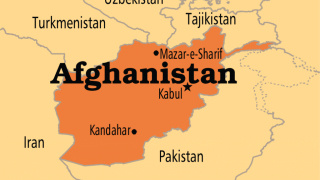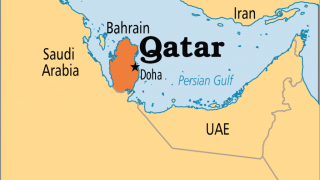A Smart-Power Approach For The Seas
In 2017 the retired US Navy admiral and former NATO Supreme Allied Commander, James Stavridis, published a book titled Sea Power: The History and Geopolitics of the World’s Oceans. It is an attractive read for military professionals, especially those serving in the Navy, as well as for historians, political scientists, and anyone interested in the complex junctures of the geographical landscape and the ways in which power is projected. Of course in this instance we are primarily talking about the environment of the sea. However, the style of the presentation and the method used to convey the material betrays a certain ideological determinism. From the very first pages the author proclaims his identity and his devotion to the cult of the sea, just like a Venetian doge presiding over a Marriage of the Sea ceremony — “Like Saint Paul on the road to Damascus, I had an epiphany: I wanted to be a sailor. In all my life, we had not been a family particularly oriented to the water, but the Pacific grabbed me by the throat and said quite simply, ‘You are home.’ I’ve never looked back” (pg. 12) — this is how James Stavridis describes his first ocean voyage in 1972 on the USS Jouett cruiser, when he was a young student at the Naval Academy. She was “beautiful and modern” — these words, spoken about a warship, are an example of the typical sort of slang used by military professionals who lavish such epithets on their equipment, almost as if they were describing a living creature.
There are nine chapters, seven of which are broken down by region — the Pacific, Atlantic, and Indian Oceans, the Mediterranean and the South China Sea, the Caribbean, the Arctic Ocean, and two chapters with themes on maritime piracy, the fishing industry, ecology, and US Naval strategy for the 21st century. The political and elective subtext is specified right up front in the table of contents.
Who would have been thinking about the South China Sea 15 years ago? The focus would have more likely been on the Persian Gulf. That trend became an object of particular interest to Washington once China successfully incorporated high-tech military equipment into its arsenal and the country started to take off economically, although run-ins in the South China Sea began to occur in the 1970s. And isn’t the conceptualization of global maritime piracy just a reason to justify the forward presence of the US Navy in the most far-flung corners of the world, under the pretext of a noble cause?
However, US interests like these are described in the first chapter from a historical perspective — such as the 1898 annexation of Hawaii, because American ships needed refueling (which awaited them at transit points known as coaling stations), and also the dramatic voyage of American Commodore Matthew Perry to Japan in the 1850s (pg. 25), which not only led to that country’s dependence on treaties with the US, but also its rapid modernization in keeping with the Western model. In describing the Russo-Turkish war, Stavridis mentions what he calls an “interesting side note” — some Russian ships surrendered to the enemy. As a result, “[w]hen the commanders came home, they were court-martialed and sentenced to death, ending for all intents and purposes the idea of surrender” (pg. 29). Stavridis claims that the US has a different philosophy — to never surrender one’s ship but rather to fight to the end.
The USS Pueblo (AGER-2), which was a reconnaissance ship disguised as a scientific vessel, was carrying a crew of over 80 sailors when it was captured by North Korean patrol boats in 1968. No one even attempted to fend off the Koreans (two machine guns remained under wraps). Nor were any of the secret documents destroyed and the equipment continued to operate right in front of the astonished Koreans who descended into the holds. In 1969 the captain was even subjected to a Naval court of inquiry in the US. That’s no surprise — for the first time in 160 years, an American ship had surrendered to the enemy, and no one had come to its rescue! But in the end no action was taken against him, since it became clear that the US military system was in such a deep “mess.”
No mention is made of the heroic resistance offered by the Russian cruiser Varyag, which acquiesced to an unequal battle with the Japanese in 1905. Those details are quite worthy of note, however, since in 1907 the commander of that ship, Admiral Vsevolod Rudnev, became the first European to be decorated with Japan’s Order of the Rising Sun, as a sign of Tokyo’s respect for his heroism in that battle.
What’s more, Theodore Roosevelt was awarded the Nobel peace prize for his role in the negotiations between Russia and Japan. When you think about the fact that the Japanese won their victory at Tsushima thanks to their superior ability to communicate by radio — a stumbling block for the Russians — one can also then discern the role played by the US, by that same Commodore Perry who had been the first to introduce Tokyo to Western technology.
Stavridis then argues that “[t]he Pacific Ocean arms race is real and it is dangerous” (pg. 41). But as they say, when you sow the wind, you reap the whirlwind.
Next, let’s take a look at the Atlantic Ocean, or the “cradle of our civilization,” as Stavridis calls it. His brief historical digression into the navigational tactics of the Greeks, the Vikings, and the Irish (St. Brendan) is fairly interesting, and those stories are blended with the admiral’s personal reminiscences. Of course five nations fought a war over the Atlantic: the Portuguese, under the rule of Prince Henry the Navigator and later Christopher Columbus; the Spanish Armada; the “creative geostrategic genius William Pitt” (pg. 60); and also France and the Netherlands, which had their own interests at stake. And then 1773 saw the Boston Tea Party, which resulted in England being stripped of its own colonies. Finally there was the Battle of Trafalgar and the American Civil War, during which both Southerners and Northerners utilized the Atlantic, plus WWI, the Battle of the Atlantic (as Churchill dubbed it), and the Falklands War in 1982 (the last military conflict in this ocean) — our author leads us through each twist and turn. At the end of the chapter he states, “The Atlantic today is, for essentially the first time in its long history, a zone of cooperation and peace from the Arctic Circle to the shores of the Antarctic in the far South” (pg. 84). And here we see the contradiction that emerges at the end of the book. In the section about pirates (pg. 285), he speaks about the Gulf of Guinea and the deltas of the Niger and the Volta where Boko Haram is active, which has forced Western nations to deploy special missions to the coast of West Africa. So we still have a long way to go before we can objectively point to peace and cooperation in the Atlantic.
The chapter on the Indian Ocean also begins with personal impressions, mixed with historical facts. One important observation is that wars have not been fought there as often as in other seas, because of the idiosyncrasies of the strategic geography. The clashes that occurred between the competing powers that bordered the Indian Ocean were primarily conducted on land. Did this predestine these countries to be afterwards partial to Land Power? It is quite possible, although they made good use of their fleets for commercial purposes, making it possible for them to establish a system of communication from China to the east coast of Africa even back in the days of antiquity.
And kudos to Stavridis for bringing up what happened to Iran Air Flight 655 when a missile from the USS Vincennes cruiser shot down an Iranian airliner carrying 290 civilian passengers. Stavridis calls it “a terrible mistake caused by the high state of tension in the region, the confusion and fog of war …” (pg. 99).
But then we get to Vasco da Gama, who is credited with “the most epic and impactful voyage of exploration in world history …” (pg. 101), and the experienced eye of a historian of oceanic exploration will immediately pick up on the omission, for where is the mention of the pilot of his ship, the native of Oman, Ahmad ibn Majid? For without this Arab navigator there would have been no discoveries in the name of Portugal. And why is there no reference to the legend of Sinbad the Sailor, who was based on a real historical figure? Robert Kaplan was more careful in his book, Monsoon: The Indian Ocean and The Future of American Power, and made note of these details.
Instead Stavridis turns his attention to the Suez Canal, although it would be better to have moved that subject to the chapter on the Mediterranean, where it would be a more logical fit.
One can discern recurring value judgments by reading between the lines, such as in reference to the Iranian government of Ayatollah Khomeini, “which truly, madly, deeply, hated the United States” (pg. 115). Such passages clearly help to entrench the negative image of Iran held by American (and other) readers of this book.
The chapter’s conclusions are quite obvious — “we must recognize the vital importance of the Indian Ocean itself … Our strategic and geopolitical mental map reflects this …” (pg. 120). The artificial narrative of the Indo-Pacific region that is promoted by the US represents an incremental realization of these intentions. India is identified as America’s primary partner on this issue. And it’s a sensible idea to bring not only NATO and Washington’s Asian partners on board for the joint fight against piracy, “but also China, India, Pakistan, and Iran.” But that will be difficult if the US continues to act like the world’s policeman, in keeping with its ideas of its own political superiority and exceptionalism.
The chapter on the Mediterranean opens with statistical data and this region’s role in world history: the Minoans, Cretans, Phoenicians, and Carthaginians; the early “clash of civilizations” between the Greeks and Persians; and the transformation of the Mediterranean into a home sea for the Romans. And then, alas, the book blunders and has only a few lines to offer about the Crusades and the Byzantine Empire. After all, Byzantium lasted longer than any other mighty power in that region. Moreover, many historians have dubbed it a “sea empire,” because of its powerful fleet and interest in controlling sea-based communication channels. Under Diocletian, Byzantium possessed several fleets — after the seventh-century reforms, a system of sea themata was established, and the phenomenon of the sea-based droungarios, was in fact, a prototype for the mobile units and interdepartmental cooperation seen today. And, of course, there was the “Greek fire” (or, more precisely, “liquid fire,” as it was called in Byzantium) and the epic naval battles — the Battle of the Masts, the defeat of the Arabs in 747 after their unsuccessful siege of Constantinople, the conquest of Cyprus and Crete from the Muslims in the second half of the tenth century, etc. Nor did the Slavs’ Siege of Constantinople rate a mention (although Ukraine, Crimea, and Russia are referred to quite freely later in the book.).
Is this evidence of his ignorance of historical facts or rather an intentional oversight in order to avoid recognizing the role played by Byzantium for centuries in the region’s maritime policy? The second option is more likely to be correct, since the Ottoman Empire is also discussed rather selectively. Laziness is the only explanation for the omission of the Battle of Lepanto, but why no references to Pasha Hayreddin Barbarossa (Khidr Reis), who inspired fear in every European power in the early 16th century? The Battle of Preveza is also worth describing, in which the Ottoman fleet was far smaller than the combined flotilla of the legendary Admiral Andrea Doria (122 ships vs. 600), yet Doria’s forces ultimately lost and beat an ignoble retreat. And keeping in mind Barbarossa’s famous saying — “whoever rules the waves rules the world” — was not Halford Mackinder‘s formula for controlling Eurasia merely a restatement of the ideas of that Ottoman admiral?
At the end of this chapter, a number of regional imperatives for NATO are suggested, including finding a solution to the problems of refugees and terrorists, although these are headaches that that organization itself created (through, for example, the destruction of Libya as a sovereign state and its support for the militants in Syria). And of course one mustn’t forget the “Russian threat” — “Russian adventurism will continue in and around the eastern Med and the Black Sea. It is clear the Med will continue to be a fickle and changing geopolitical body of water …” (pg. 162).
A fairly lengthy chapter on the Caribbean betrays the author’s desire to demonstrate the significance of this region. And how. Back in the era of great geographical discoveries, this was the place where the European empires deployed their most sophisticated resources against one another, and since they were far from the shores of their home countries, this posed certain risks. Only passing mention is made of Guantanamo Bay, which has garnered international notoriety due to the vast number of people who have been held there who were suspected of having links to al-Qaeda. Many were captured in Afghanistan and were kept there for years without ever being charged or tried. Yet these facts are cited as if Gitmo were a legitimate military base for the US Navy, and not a chunk of occupied Cuban territory. And the intervention in Haiti and Grenada is presented as a mere matter of course. Once Reagan decided that the government there posed a threat to the American citizens in that country, orchestrating a coup became a distinct possibility. “That the government also had Marxist tendencies was an additional problem. The United States invaded Grenada …” (pg. 226).
The Arctic chapter is primarily devoted to the territorial disputes of the Arctic nations, the environment, and the natural resources. Somehow the fact was left out that the Arctic is also extremely convenient in a strategic sense — a missile launched from a Russian submarine at the North Pole will fly much faster to the American coastline than one from a land-based installation. And one passage offers evidence of what is clearly a misunderstanding by Stavridis of the mentality of the Russian nation — “The Arctic is also a part of the world that figures deeply in the Russian mind-set and self-image as a nation of rugged individualists who are capable of surviving in the harshest of conditions” (pg. 247). Excuse me, but how could individualists survive in this harsh environment? On the contrary, here we see in action the principle of mutual assistance and support. Even small groups would fare better under such conditions than individualists, who wouldn’t be able to accomplish much, if anything. In this chapter, Stavridis suggests that the US shore up its leadership role in the Arctic Council, construct more icebreakers, and continue to call the shots in the Arctic through NATO, but also to begin a dialog with Russia. Russia is superior to the US in the Arctic both in terms of military and technology, so Washington will not be the one dictating the terms there.
Incidentally, discussions of the Arctic are usually conflated with analysis of the Antarctic. They’re both mostly water, after all. But Stavridis avoids doing that. The Antarctic, in case you need a reminder, was discovered by Russian navigators. And yes, the idea of maritime law was also a Russian idea — suggested during the era of Catherine II.
The conclusions at the end of the book are entirely predictable — the US needs to preserve its presence and influence wherever possible. In the author’s view, this applies not only to the Navy, but also to all the various installations and elements of the missile defense system. This is the notion behind the global network referred to in the document “A Cooperative Strategy for 21st Century Seapower,” which was published in 2015, and can also be found in the concept of global alliances and partnerships that was pioneered by Admiral Alfred Thayer Mahan.
Therefore, it is quite logical that the final chapter, “America and the Oceans,” discusses the Eurasian continent, Halford Mackinder’s “World Island,” and land-based forces, which (here Stavridis paraphrases Mahan) need to be offset by naval forces acting as a counterweight. But since Mahan’s day there have been significant changes related to military technology and strategy. Russia’s and China’s submarine and surface power is growing, aircraft carriers have become vulnerable to missiles, and command-and-control systems can be subjected to cyberattacks. All this presents different environments and challenges for any sea power. Stavridis suggests supplementing Mahan’s formula (a large fleet, forward deployment, and secure logistics) with cooperation that is international (including through NATO), inter-agency, and public-private in nature. This could create a “smart-power approach for the seas” (pg. 342).
Source: Oriental Review











